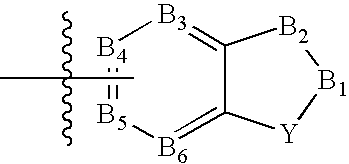Biaryl substituted diazabicycloalkane derivatives
a technology of diazabicycloalkane and biaryl, which is applied in the direction of antibacterial agents, antinoxious agents, immunological disorders, etc., can solve the problems of addictive and acutelyoxic, limiting the ability of patients to function normally, and not all the effects mediated by nicotine are desirabl
- Summary
- Abstract
- Description
- Claims
- Application Information
AI Technical Summary
Benefits of technology
Problems solved by technology
Method used
Image
Examples
example 1
5-{5-[(1S,5S)-3,6-diazabicyclo[3.2.0]heptan-3-yl]pyridin-3-yl}-1H-indole Bistosylate
example 1a
(1R,5S)-tert-butyl 3-(5-bromopyridin-3-yl)-3,6-diazabicyclo[3.2.01]heptane-6-carboxylate
[0224]3,5-dibromopyridine (Aldrich, 2.60 g, 15 mmol) was coupled with (1R,5S)-tert-butyl 3,6-diazabicyclo[3.2.0]heptane-6-carboxylate (US 2006035936, 1.98 g, 10 mmol) under the catalysis of Pd2(dba)3 (Aldrich, 183.6 mg, 0.2 mmol) and 2,2′-bis(diphenylphosphino)-1,1′-binaphthyl (Aldrich, 373 mg, 0.6 mmol) in the presence of Cs2CO3 (Aldrich, 6.50 g, 20.0 mmol) in toluene (anhydrous, Aldrich, 50 mL) at 110° C. for 48 h. After the completion of the reaction, the reaction mixture was cooled to ambient temperature and diluted with EtOAc (100 mL). The inorganic solid was filtered off. The organic solution was washed with brine (2×20 mL) and concentrated under reduced pressure. The residue was purified with chromatography (SiO2, EtOAc / hexane, v. 50 / 50, Rf=0.40) to give the title compound (3.05 g, yield, 86%). 1H NMR (300 MHz, CD3OD) δ ppm 1.45 (s, 9H), 2.95 (dd, J=11.02, 4.24 Hz, 1H), 3.05 (dd, J=10.51, ...
example 1b
(1R,5S)-tert-butyl 3-[5-(1H-indol-5-yl)pyridin-3-yl]-3,6-diazabicyclo[3.2.0]heptane-6-carboxylate
[0225]The product of Example 1A (1.0 g, 2.82 mmol) was coupled with 1H-indol-5-ylboronic acid (Frontier, 677 mg, 4.23 mmol) under the catalysis of Pd2(dba)3 (Aldrich, 18.4 mg, 0.02 mmol) and Pd(tBu3P)2 (Strem Chemicals, 20.5 mg, 0.04 mmol) with CsF (Aldrich, 2.55 g, 17 mmol) in dioxane (50 mL) at 80° C. for 15 h. After the reaction was completed, it was cooled to ambient temperature and diluted with EtOAc (100 mL). The mixture was then washed with brine (2×20 mL) and concentrated. The residue was purified with chromatography (SiO2, EtOAc / hexane, v. 50 / 50, Rf=0.40) to give the title compound (1.05 g, yield, 95%). 1H NMR (300 MHz, CD3OD) δ ppm 1.45 [s (br.), 9H], 2.87-2.99 (m, 1H), 3.05 (dd, J=10.22, 6.56 Hz, 1H), 3.15-3.30 (m, 2H), 3.55-3.75 (m, 1H), 3.82-3.93 (m, 1H), 3.96-4.26 (m, 3H), 6.53 (d, J=2.75 Hz, 1H), 7.28 (d, J=3.05 Hz, 1H) 7.39 (dd, 1H) 7.43 (s, 1H) 7.49 (d, J=8.54 Hz, 1H) 7....
PUM
 Login to View More
Login to View More Abstract
Description
Claims
Application Information
 Login to View More
Login to View More - R&D
- Intellectual Property
- Life Sciences
- Materials
- Tech Scout
- Unparalleled Data Quality
- Higher Quality Content
- 60% Fewer Hallucinations
Browse by: Latest US Patents, China's latest patents, Technical Efficacy Thesaurus, Application Domain, Technology Topic, Popular Technical Reports.
© 2025 PatSnap. All rights reserved.Legal|Privacy policy|Modern Slavery Act Transparency Statement|Sitemap|About US| Contact US: help@patsnap.com



